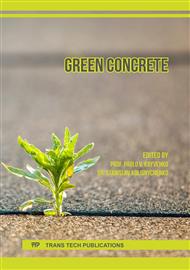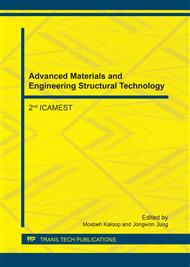[1]
O. A. Mohamed, Z. I. Syed, O. F. Najm, Splitting tensile strength of sustainable self-consolidating concrete. International Conference on Sustainable Design, Engineering and Construction, Elsevier Ltd., (2016), pp.1218-1225.
DOI: 10.1016/j.proeng.2016.04.157
Google Scholar
[2]
ACI 363R. Report on high strength concrete. Farmington Hills: American Concrete Institute, (2010).
Google Scholar
[3]
F. A. Oluokun, Prediction of Concrete Tensile Strength from Its Compressive Strength: Evaluation of Existing Relations for Normal Weight Concrete, Aci Mater. J. 88(3) (1991) 302-309.
DOI: 10.14359/1942
Google Scholar
[4]
F. A. Oluokun, E. G. Burdette, J. H. Deatherage, Splitting Tensile Strength and Compressive Strength Relationship at Early Ages, ACI Mater. J. 88(2) (1991) 115-121.
DOI: 10.14359/1859
Google Scholar
[5]
S. F. Freyne, B. W. Russell, T. D. Bush, W. M. Hale, Comparing Different Cements in High-Performance Concrete, ACI Mater. J. 101(6) (2004) 435-441.
Google Scholar
[6]
C. Gaedicke, A. Torres, K. Huynh, A. Marines, A method to correlate splitting tensile strength and compressive strength of pervious concrete cylinders and cores. Construction and Building Materials, Elsevier, (2016), pp.271-278.
DOI: 10.1016/j.conbuildmat.2016.08.031
Google Scholar
[7]
M. F. Zain, H. B. Mahmud, A. Ilham, M. Faizal, Prediction of splitting tensile strength of high-performance concrete. Cement and Concrete Research, Pergamon, (2002), pp.1251-1258.
DOI: 10.1016/s0008-8846(02)00768-8
Google Scholar
[8]
C. Druta, Tensile strength and bonding characteristics of self-compacting concrete. M.A. Thesis, Louisiana State University, Louisiana, (2003).
DOI: 10.31390/gradschool_theses.4228
Google Scholar
[9]
ASTM- C 39, Standard Test Method for Compressive Strength of Cylindrical Concrete Specimens. West Conshohocken: ASTM international, (1994).
Google Scholar
[10]
ASTM- C496, Standard Test Method for Splitting Tensile Strength of Cylindrical Concrete Specimens. West Conshohocken: ASTM international, (1996).
Google Scholar
[11]
ACI 318, Building code requirements for structural concrete and commentary, American Concrete Institute, Farmington Hills, Mich, (2014).
Google Scholar
[12]
ACI 363R, State-of-the-Art Report on High-Strength Concrete, American Concrete Institute, Farmington Hills, Mich, (1992).
Google Scholar
[13]
JSCE, Standard specifications for concrete structures-2002, Materials and Construction, Japan Society of Civil Engineers, (2002).
Google Scholar
[14]
JSCE, Standard specifications for concrete structures-2007, Materials and Construction, Japan Society of Civil Engineers, (2007).
Google Scholar
[15]
CEB-FIB Model Code for Concrete Structures, Evaluation of the Time Dependent Behaviour of Concrete, (1991).
Google Scholar
[16]
J. M. Raphael, Tensile Strength of Concrete, ACI J. Proceed. 81(2) (1984) 158-165.
Google Scholar
[17]
N. J. Gardner, Effect of Temperature on the Early-Age Properties of Type I, Type III, and Type I/Fly Ash Concretes, ACI Mater. J. 87(1) (1990) 68-78.
DOI: 10.14359/2381
Google Scholar



